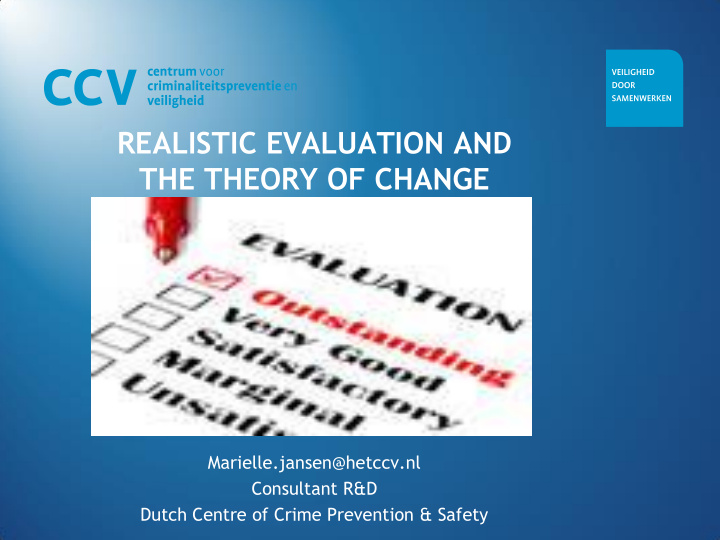



REALISTIC EVALUATION AND THE THEORY OF CHANGE Marielle.jansen@hetccv.nl Consultant R&D Dutch Centre of Crime Prevention & Safety
REALISTIC EVALUATION (CMO) Pawson & Tilley (1997) Context Mechanisms Outcome Target group Mechanisms Desired outcome induced by the intervention Problem Possible side effects will lead to Conditions, a certain outcome circumstances in a certain context 5 december 2016 | 2
CMO MODEL: THE APP-CHECK ACM (2006) Context Mechanisms Outcome Consumers Inform consumers Consumers ’ privacy about what (while using apps) happens with their is protected Are not aware of personal data how app-hosts use their Possible side personal data by providing them effects: consumers with a checklist are more aware of privacy risks in when installing general apps will change their app use 5 december 2016 | 3
THEORY OF CHANGE • Identify long-term goals • Map and connect the preconditions or requirements necessary to achieve set goals • Identify basic assumptions about the context • Find proof for the assumptions in the theory • Develop indicators to measure the outcomes 5 december 2016 | 4
HOW DOES IT WORK? https://www.youtube.com/watch?v=dpb4AGT684U&feature=youtu.be 5 december 2016 | 5
THEORY OF CHANGE 5 december 2016 | 6
THEORY OF CHANGE: THE APP CHECK Campaign to attract Side effects consumers attention Checklist ‘how to protect my privacy’ on ACM website Consuwijzer) Consumer will take notice of the checklist Consumer will use the checklist Consumer will know if External factors an app is safe or not Consumer will not install app if not safe Consumers privacy is protected 5 december 2016 | 7
INDICATORS FOR EFFECTIVENESS • Consumers are familiar with the campaign • Consumers are familiar with the checklist • Consumers know how to use the checklist • Consumers use the checklist • Consumers are able to detect if an app is safe • Consumers make well-founded decisions when installing apps 5 december 2016 | 8
TAKE HOME • Describe the context (problem, target group, circumstances) • Describe the step-by-step problem-solving procedure • Choose an intervention that best fits the desired outcome • Find evidence for assumptions in the constructed theory • Apply the new measure or intervention • Monitor the proces and results of the intervention 5 december 2016 | 9
QUESTIONS? 5 december 2016 | 10
THANK YOU FOR YOUR ATTENTION! See/read also: http://www.communitymatters.com.au/RE_chapter.pdf http://www.theoryofchange.org/ 5 december 2016 | 11
Recommend
More recommend